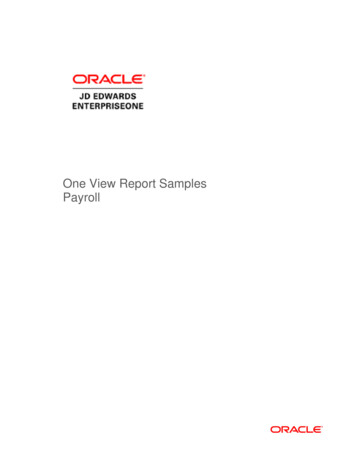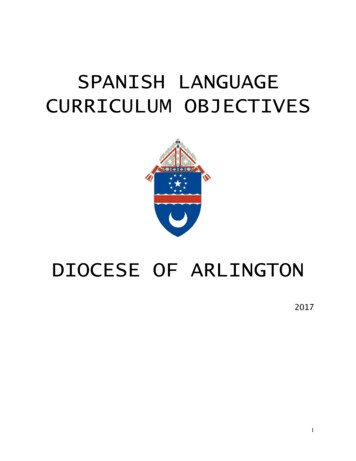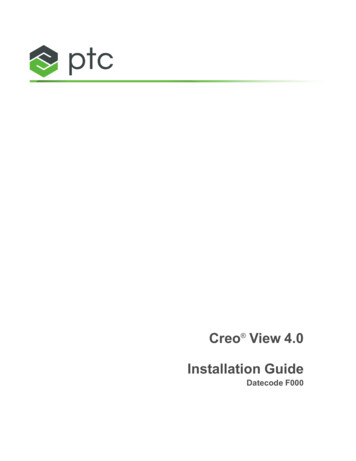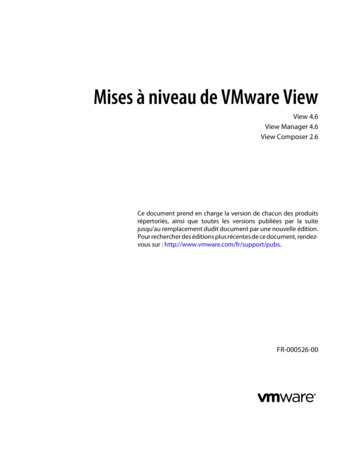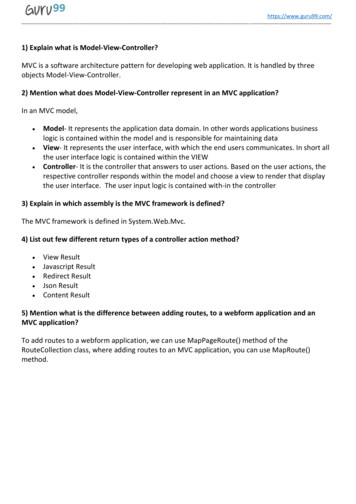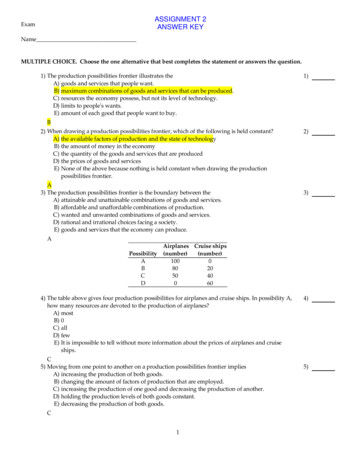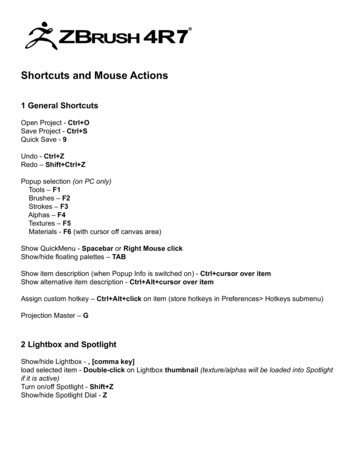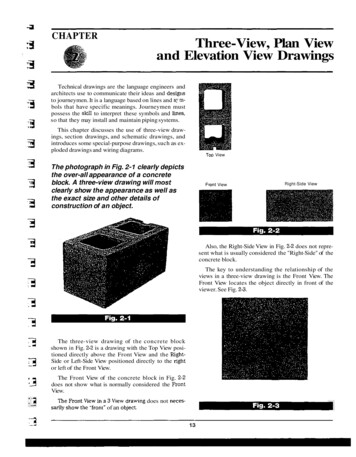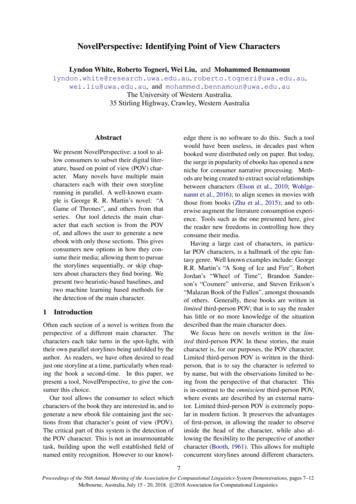
Transcription
NovelPerspective: Identifying Point of View CharactersLyndon White, Roberto Togneri, Wei Liu, and Mohammed Bennamounlyndon.white@research.uwa.edu.au, roberto.togneri@uwa.edu.au,wei.liu@uwa.edu.au, and mohammed.bennamoun@uwa.edu.auThe University of Western Australia.35 Stirling Highway, Crawley, Western AustraliaAbstractedge there is no software to do this. Such a toolwould have been useless, in decades past whenbooked were distributed only on paper. But today,the surge in popularity of ebooks has opened a newniche for consumer narrative processing. Methods are being created to extract social relationshipsbetween characters (Elson et al., 2010; Wohlgenannt et al., 2016); to align scenes in movies withthose from books (Zhu et al., 2015); and to otherwise augment the literature consumption experience. Tools such as the one presented here, givethe reader new freedoms in controlling how theyconsume their media.Having a large cast of characters, in particular POV characters, is a hallmark of the epic fantasy genre. Well known examples include: GeorgeR.R. Martin’s “A Song of Ice and Fire”, RobertJordan’s “Wheel of Time”, Brandon Sanderson’s “Cosmere” universe, and Steven Erikson’s“Malazan Book of the Fallen”, amongst thousandsof others. Generally, these books are written inlimited third-person POV; that is to say the readerhas little or no more knowledge of the situationdescribed than the main character does.We focus here on novels written in the limited third-person POV. In these stories, the maincharacter is, for our purposes, the POV character.Limited third-person POV is written in the thirdperson, that is to say the character is referred toby name, but with the observations limited to being from the perspective of that character. Thisis in-contrast to the omniscient third-person POV,where events are described by an external narrator. Limited third-person POV is extremely popular in modern fiction. It preserves the advantagesof first-person, in allowing the reader to observeinside the head of the character, while also allowing the flexibility to the perspective of anothercharacter (Booth, 1961). This allows for multipleconcurrent storylines around different characters.We present NovelPerspective: a tool to allow consumers to subset their digital literature, based on point of view (POV) character. Many novels have multiple maincharacters each with their own storylinerunning in parallel. A well-known example is George R. R. Martin’s novel: “AGame of Thrones”, and others from thatseries. Our tool detects the main character that each section is from the POVof, and allows the user to generate a newebook with only those sections. This givesconsumers new options in how they consume their media; allowing them to pursuethe storylines sequentially, or skip chapters about characters they find boring. Wepresent two heuristic-based baselines, andtwo machine learning based methods forthe detection of the main character.1IntroductionOften each section of a novel is written from theperspective of a different main character. Thecharacters each take turns in the spot-light, withtheir own parallel storylines being unfolded by theauthor. As readers, we have often desired to readjust one storyline at a time, particularly when reading the book a second-time. In this paper, wepresent a tool, NovelPerspective, to give the consumer this choice.Our tool allows the consumer to select whichcharacters of the book they are interested in, and togenerate a new ebook file containing just the sections from that character’s point of view (POV).The critical part of this system is the detection ofthe POV character. This is not an insurmountabletask, building upon the well established field ofnamed entity recognition. However to our knowl7Proceedings of the 56th Annual Meeting of the Association for Computational Linguistics-System Demonstrations, pages 7–12Melbourne, Australia, July 15 - 20, 2018. c 2018 Association for Computational Linguistics
and named entity tags. We do not perform coreference resolution, working only with direct entity mentions. From this, features are extracted foreach named entity. These feature vectors are usedto score the entities for the most-likely POV character. The highest scoring character is returned bythe system. The different systems presented modify the Feature Extraction and Character Scoring steps. A broadly similar idea, for detecting thefocus location of news articles, was presented by(Imani et al., 2017).Our tool helps users un-entwine such storylines,giving the option to process them sequentially.The utility of dividing a book in this way varieswith the book in question. Some books will ceaseto make sense when the core storyline crosses overdifferent characters. Other novels, particularly inepic fantasy genre, have parallel storylines whichonly rarely intersect. While we are unable to finda formal study on this, anecdotally many readersspeak of: “Skipping the chapters about the boring characters.”2.1To the best of our knowledge no systems havebeen developed for this task before. As such, wehave developed two deterministic baseline character classifiers. These are both potentially useful tothe end-user in our deployed system (Section 5),and used to gauge the performance of the morecomplicated systems in the evaluations presentedin Section 4.It should be noted that the baseline systems,while not using machine learning for the character classification steps, do make extensive use ofmachine learning-based systems during the preprocessing stages. “Only reading the real main character’s sections.” “Reading ahead, past the side-stories, to geton with the main plot.”Particularly if they have read the story before, andthus do not risk confusion. Such opinions are amatter of the consumer’s personal taste. The NovelPerspective tool gives the reader the option tocustomise the book in this way, according to theirpersonal preference.We note that sub-setting the novel once does notprevent the reader from going back and reading theintervening chapters if it ceases to make sense, orfrom sub-setting again to get the chapters for another character whose path intersects with the storyline they are currently reading. We can personally attest for some books reading the chapters onecharacter at a time is indeed possible, and pleasant: the first author of this paper read George R.R.Martin’s “A Song of Ice and Fire” series in exactlythis fashion.The primary difficulty in segmenting ebooksthis way is attributing each section to its POV character. That is to say detecting who is the pointof view character. Very few books indicate thisclearly, and the reader is expected to infer it during reading. This is easy for most humans, but automating it is a challenge. To solve this, the core ofour tool is its character classification system. Weinvestigated several options which the main text ofthis paper will discuss.2Baseline systems2.1.1“First Mentioned” EntityAn obvious way to determine the main characterof the section is to select the first named entity.We use this to define the “First Mentioned” baseline In this system, the Feature Extraction stepis simply retrieving the position of the first use ofeach name; and the Character Scoring step assigns each a score such that earlier is higher. Thisworks for many examples: “One dark and stormynight, Bill heard a knock at the door.”; however itfails for many others: “ ‘Is that Tom?’ called outBill, after hearing a knock.’’. Sometimes a section may go several paragraphs describing eventsbefore it even mentions the character who is perceiving them. This is a varying element of style.2.1.2“Most Mentioned” EntityA more robust method to determine the main character, is to use the occurrence counts. We callthis the “Most Mentioned” baseline. The Feature Extraction step is to count how often thename is used. The Character Scoring step assigns each a score based what proportional of allnames used were for this entity. This works wellfor many books. The more important a characterCharacter Classification SystemsThe full NovelPerspective pipeline is shown inFigure 1. The core character classification step(step 3), is detailed in Figure 2. In this step theraw text is first enriched with parts of speech,8
1.Useruploadsebookoriginal ebook settings2.File isconverted listSections areUser selectsclassifed by charactersectionsSee Figure 2to keepsectionselection5.Subsettedebookis creatednewebook6.Userdownloadsnew ebookFigure 1: The full NovelPerspective pipeline. Note that step 5 uses the original ebook to subset.rawtextTokenizationPOS TaggingNamed Entity racter-namescore pairspairsCharacterFeaturePOV ameFigure 2: The general structure of the character classification systems. This repeated for each section ofthe book during step 3 of the full pipeline shown in Figure 1.give information about how the each named entitytoken was used in the text.The “Classical” feature set uses features that arewell established in NLP related tasks. The featurescan be described as positional features, like in theFirst Mentioned baseline; occurrence count features, like in the Most Mentioned baseline and adjacent POS counts, to give usage context. The positional features are the index (in the token counts)of the first and last occurrence of the named entity. The occurrence count features are simply thenumber of occurrences of the named entity, supplemented with its rank on that count comparedto the others. The adjacent POS counts are theoccurrence counts of each of the 46 POS tags onthe word prior to the named entity, and on theword after. We theorised that this POS information would be informative, as it seemed reasonable that the POV character would be describedas doing more things, so co-occurring with moreverbs. This gives 100 base features. To allow fortext length invariance we also provide each of thebase features expressed as a portion of its maximum possible value (e.g. for a given POS tag occurring before a named entity, the potion of timesthis tag occurred). This gives a total of 200 features.The “Word Embedding” feature set uses FastText word vectors (Bojanowski et al., 2017). Weuse the pretrained 300 dimensional embeddingstrained on English Wikipedia 1 . We concatenate the 300 dimensional word embedding for theword immediately prior to, and immediately after each occurrence of a named entity; and takethe element-wise mean of this concatenated vectorover all occurrences of the entity. Such averages ofword embeddings have been shown to be a usefulis, the more often their name occurs. However,it is fooled, for example, by book chapters thatare about the POV character’s relationship with asecondary character. In such cases the secondarycharacter may be mentioned more often.2.2Machine learning systemsOne can see the determination of the main character as a multi-class classification problem. Fromthe set of all named entities in the section, classifythat section as to which one is the main character.Unlike typical multi-class classification problemsthe set of possible classes varies per section beingclassified. Further, even the total set of possiblenamed characters, i.e. classes, varies from book tobook. An information extraction approach is required which can handle these varying classes. Assuch, a machine learning model for this task cannot incorporate direct knowledge of the classes(i.e. character names).We reconsider the problem as a series of binary predictions. The task is to predict if a givennamed entity is the point of view character. Foreach possible character (i.e. each named-entitythat occurs), a feature vector is extracted (see Section 2.2.1). This feature vector is the input to abinary classifier, which determines the probabilitythat it represents the main character. The Character Scoring step is thus the running of the binaryclassifier: the score is the output probability normalised over all the named entities.2.2.1Feature Extraction for MLWe investigated two feature sets as inputs forour machine learning-based solution. They correspond to different Feature Extraction steps inFigure 2. A hand-engineered feature set, that wecall the “Classical” feature set; and a more modern“Word Embedding” feature set. Both feature s.html9
Datasetfeature in many tasks (White et al., 2015; Mikolovet al., 2013). This has a total of 600 features.2.2.2ClassifierThe binary classifier, that predicts if a named entity is the main character, is the key part of theCharacter Scoring step for the machine learningsystems. From each text in the training dataset wegenerated a training example for every named entity that occurred. All but one of these was a negative example. We then trained it as per normalfor a binary classifier. The score for a character isthe classifier’s predicted probability of its featurevector being for the main character.Our approach of using a binary classifier torate each possible class, may seem similar to theone-vs-rest approach for multi-class classification.However, there is an important difference. Oursystem only uses a single binary classifier; not oneclassifier per class, as the classes in our case varywith every item to be classified. The fundamentalproblem is information extraction, and the classifier is a tool for the scoring which is the correctinformation to report.With the classical feature set we use logisticregression, with the features being preprocessedwith 0-1 scaling. During preliminary testing wefound that many classifiers had similar high degree of success, and so chose the simplest. Withthe word embedding feature set we used a radialbias support vector machine, with standardisationduring preprocessing, as has been commonly usedwith word embeddings on other tasks.33.1ChaptersPOV ble 1: The number of chapters and point of viewcharacters for each dataset.ground truth for the main character in the chapternames. Every chapter only uses the POV of thatnamed character. WOT’s ground truth comes froman index created by readers.2 We do not have anydatasets with labelled sub-chapter sections, thoughthe tool does support such works.The total counts of chapters and characters inthe datasets, after preprocessing, is shown in Table 1. Preprocessing consisted of discarding chapters for which the POV character was not identified (e.g. prologues); and of removing the character names from the chapter titles as required.3.2Evaluation DetailsIn the evaluation, the systems are given the bodytext and asked to predict the character names. During evaluation, we sum the scores of the characters alternative aliases/nick-names used in thebooks. For example merging Ned into Eddardin ASOIAF. This roughly corresponds to the casethat a normal user can enter multiple aliases intoour application when selecting sections to keep.We do not use these aliases during training, thoughthat is an option that could be investigated in a future work.Experimental SetupDatasets3.3We make use of three series of books selected fromour own personal collections. The first four booksof George R. R. Martin’s “A Song of Ice and Fire”series (hereafter referred to as ASOIAF); The twobooks of Leigh Bardugo’s “Six of Crows” duology(hereafter referred to as SOC); and the first 9 volumes of Robert Jordan’s “Wheel of Time” series(hereafter referred to as WOT). In Section 4 weconsider the use of each as a training and testingdataset. In the online demonstration (Section 5),we deploy models trained on the combined totalof all the datasets.To use a book for the training and evaluation ofour system, we require a ground truth for each section’s POV character. ASOIAF and SOC provideImplementationThe full source code is available on GitHub. 3Scikit-Learn (Pedregosa et al., 2011) is used forthe machine learning and evaluations, and NLTK(Bird and Loper, 2004) is used for textual preprocessing. The text is tokenised, and tagged withPOS and named entities using NLTK’s defaultmethods. Specifically, these are the Punkt sentence tokenizer, the regex-based improved TreeBank word tokenizer, greedy averaged perceptronPOS tagger, and the max-entropy binary namedentity chunker. The use of a binary, rather than2http://wot.wikia.com/wiki/List ofPoint of View ctive/10
Test SetMethodTrain FFirst MentionedMost MentionedML Classical FeaturesML Classical FeaturesML Classical FeaturesML Word Emb. FeaturesML Word Emb. FeaturesML Word Emb. Features——SOCWOTSOCSOCSOCSOCSOCSOCSOCSOCFirst MentionedMost MentionedML Classical FeaturesML Classical FeaturesML Classical FeaturesML Word Emb. FeaturesML Word Emb. FeaturesML Word Emb. FeaturesWOTWOTWOTWOTWOTWOTWOTWOTFirst MentionedMost MentionedML Classical FeaturesML Classical FeaturesML Classical FeaturesML Word Emb. FeaturesML Word Emb. FeaturesML Word Emb. FeaturesWOT SOCSOCWOTWOT SOC——WOTASOIAFWOT ASOIAFWOTASOIAFWOT ASOIAF——SOCASOIAFASOIAF SOCSOCASOIAFASOIAF SOCAccTest SetMethodTrain AFASOIAFML Classical FeaturesML Word Emb. FeaturesASOIAFASOIAF0.9800.988SOCSOCML Classical FeaturesML Word Emb. FeaturesSOCSOC0.9450.956WOTWOTML Classical FeaturesML Word Emb. FeaturesWOTWOT0.7850.794Table 3: The training set accuracy of the machinelearning character classifier o training sets does not always out-perform eachon their own. For many methods training on justone dataset resulted in better results. We believethat the difference between the top result for amethod and the result using the combined training sets is too small to be meaningful. It can, perhaps, be attributed to a coincidental small similarity in writing style of one of the training books tothe testing book. To maximise the generalisabilityof the NovelPerspective prototype (see Section 5),we deploy models trained on all three datasetscombined.Almost all the machine learning models resulted in similarly high accuracy. The exceptionto this is word embedding features based modeltrained on SOC, which for both ASOIAF andWOT test sets performed much worse. We attribute the poor performance of these models tothe small amount of training data. SOC has only91 chapters to generate its training cases from, andthe word embedding feature set has 600 dimensions. It is thus very easily to over-fit which causesthese poor results.Table 3 shows the training set accuracy of eachmachine learning model. This is a rough upperbound for the possible performance of these models on each test set, as imposed by the classifierand the feature set. The WOT bound is muchlower than the other two texts. This likely relates to WOT being written in a style that closerto the line between third-person omniscient, thanthe more clear third-person limited POV of theother texts. We believe longer range features arerequired to improve the results for WOT. However, as this achieves such high accuracy for theother texts, further features would not improve accuracy significantly, without additional more difficult training data (and may cause over-fitting).The results do not show a clear advantage to either machine learning feature set. Both the classical features and the word embeddings work well.0.0440.6600.7010.7450.7360.5510.6990.681Table 2: The results of the character classifier systems. The best results are bolded.a multi-class, named entity chunker is significant.Fantasy novels often use “exotic” names for characters, we found that this often resulted in character named entities being misclassified as organisations or places. Note that this is particularly disadvantageous to the First Mentioned baseline, asany kind of named entity will steal the place. Nevertheless, it is required to ensure that all characternames are a possibility to be selected.4Results and DiscussionOur evaluation results are shown in Table 2 for allmethods. This includes the two baseline methods,and the machine learning methods with the different feature sets. We evaluate the machine learningmethods using each dataset as a test set, and usingeach of the other two and their combination as thetraining set.The First Mentioned baseline is very weak. TheMost Mentioned baseline is much stronger. In almost all cases machine learning methods outperform both baselines. The results of the machinelearning method on the ASOIAF and SOC are verystrong. The results for WOT are weaker, thoughthey are still accurate enough to be useful whencombined with manual checking.It is surprising that using the combination of11
Acknowledgements This research was partiallyfunded by Australian Research Council grantsDP150102405 and LP110100050.Though, it seems that the classical feature aremore robust; both with smaller training sets (likeSOC), and with more difficult test sets (like WOT).5Demonstration SystemReferencesThe demonstration system is deployed online athttps://white.ucc.asn.au/tools/np.A video demonstrating its use can be found athttps://youtu.be/iu41pUF4wTY. Thisweb-app, made using the CherryPy framework,4allows the user to apply any of the modeldiscussed to their own novels.The web-app functions as shown in Figure 1.The user uploads an ebook, and selects one ofthe character classification systems that we havediscussed above. They are then presented with apage displaying a list of sections, with the predicted main character(/s) paired with an excerptfrom the beginning of the section. The user canadjust to show the top-k most-likely characters onthis screen, to allow for additional recall.The user can select sections to retain. Theycan use a regular expression to match the character names(/s) they are interested in. The sectionswith matching predicted character names will beselected. As none of the models is perfect, somemistakes are likely. The user can manually correctthe selection before downloading the book.6Bird, S. and Loper, E. (2004). Nltk: the natural language toolkit. In Proceedings of the ACL 2004on Interactive poster and demonstration sessions,page 31. Association for Computational Linguistics.Bojanowski, P., Grave, E., Joulin, A., and Mikolov, T.(2017). Enriching word vectors with subword information. Transactions of the Association for Computational Linguistics, 5:135–146.Booth, W. C. (1961). The rhetoric of fiction. University of Chicago Press.Elson, D. K., Dames, N., and McKeown, K. R. (2010).Extracting social networks from literary fiction. InProceedings of the 48th Annual Meeting of the Association for Computational Linguistics, ACL ’10,pages 138–147, Stroudsburg, PA, USA. Associationfor Computational Linguistics.Imani, M. B., Chandra, S., Ma, S., Khan, L., and Thuraisingham, B. (2017). Focus location extractionfrom political news reports with bias correction. In2017 IEEE International Conference on Big Data(Big Data), pages 1956–1964.Mikolov, T., Sutskever, I., Chen, K., Corrado, G. S.,and Dean, J. (2013). Distributed representationsof words and phrases and their compositionality.In Advances in Neural Information Processing Systems, pages 3111–3119.ConclusionPedregosa, F., Varoquaux, G., Gramfort, A., Michel, V.,Thirion, B., Grisel, O., Blondel, M., Prettenhofer, P.,Weiss, R., Dubourg, V., Vanderplas, J., Passos, A.,Cournapeau, D., Brucher, M., Perrot, M., and Duchesnay, E. (2011). Scikit-learn: Machine learningin Python. Journal of Machine Learning Research,12:2825–2830.We have presented a tool to allow consumers to restructure their ebooks around the characters theyfind most interesting. The system must discoverthe named entities that are present in each section of the book, and then classify each sectionas to which character’s point of view the sectionis narrated from. For named entity detection wemake use of standard tools. However, the classification is non-trivial. In this design we implemented several systems. Simply selecting themost commonly named character proved successful as a baseline approach. To improve upon this,we developed several machine learning based approaches which perform very well. While noneof the classifiers are perfect, they achieve highenough accuracy to be useful.A future version of our application will allowthe users to submit corrections, giving us moretraining data. However, storing this informationposes copyright issues that are yet to be resolved.4White, L., Togneri, R., Liu, W., and Bennamoun,M. (2015). How well sentence embeddings capture meaning. In Proceedings of the 20th Australasian Document Computing Symposium, ADCS’15, pages 9:1–9:8. ACM.Wohlgenannt, G., Chernyak, E., and Ilvovsky, D.(2016). Extracting social networks from literary textwith word embedding tools. In Proceedings of theWorkshop on Language Technology Resources andTools for Digital Humanities (LT4DH), pages 18–25.Zhu, Y., Kiros, R., Zemel, R., Salakhutdinov, R., Urtasun, R., Torralba, A., and Fidler, S. (2015). Aligning books and movies: Towards story-like visual explanations by watching movies and reading books.In Proceedings of the IEEE international conferenceon computer vision, pages 19–27.http://cherrypy.org/12
"Malazan Book of the Fallen", amongst thousands of others. Generally, these books are written in . 5. Subsetted ebook is created 6. User downloads new ebook original ebook settings section content section-character list section selection new ebook Figure 1: The full NovelPerspective pipeline. Note that step 5 uses the original ebook to .

